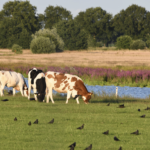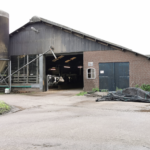First published: April 10, 2020
By Jonathan Verschuuren
The rapid global spread of the infectious disease Covid-19 by the SARS-CoV-2 virus is shaking the world to its foundations. Many call it the greatest health crisis since the Spanish flu of 1918. Besides a health crisis, this is also an environmental crisis. After all, environmental problems underlie the rapid rise of infectious diseases in recent decades.
Viruses are parasites that live in wild animals without those animals noticing or bothering them. This “home base” of a virus is called a reservoir. It is estimated that 320,000 species of virus live in mammals alone. Only a fraction (less than 6,000) of these have been discovered. The most recent discovery concerns SARS-CoV-2. Viruses are thought to have existed as long as there is life on Earth. They only become harmful to humans and other animal species if they somehow escape from that reservoir and spread and multiply in all sorts of very ingenious ways. The rabies virus, for example, induces a dog to bite around so that the virus can spread, the SARS-CoV-2 virus hijacks the RNA material in human cells to multiply quickly, and the influenza virus constantly adapts to bypass the immune system.
When a virus escapes and jumps to a humans is called spillover. Such a spillover can go directly from reservoir to human, but often it happens via an intermediate step, for example a pig, a horse, a chicken, a dog. Those intermediates are called a host, from which the virus infects humans. Sometimes insects act as transmitters, called vector, such as with malaria. Besides viruses, bacteria that cause deadly infectious diseases also jump from animals to humans. Q-fever and Lyme disease are examples of this. An infectious disease that originates from animals is called zoonosis.
Of course I did not invent all this myself. I largely derive it from the book “Spillover” by the American science journalist David Quammen. Although this book dates back to 2012, it is incredibly current. It is an exciting and shocking book. Exciting because Quammen takes us on a journey around the world with scientists who research viruses and viral diseases. This detective work is very risky and complex. Shocking because Quammen (following many scientists) already predicted quite precisely in 2012 that what we are now experiencing was about to happen. He even refers to a wet market in China, where wildlife is traded for consumption, as the site of the jump, and to a corona virus as a good candidate for the next pandemic. Shocking also because the book takes you along all kinds of other animal-derived infectious diseases and makes you realize that we are actually well off with SARS-CoV-2. After all, there are also viruses that show mortality rates of 70% or even 100%. In this sense, the current corona virus is still a relatively friendly virus. I leave it to your imagination to think about what the world looks like with a pandemic of a virus with a mortality rate of 70%.
The number of zoonoses has increased sharply in recent decades. The best known example is the HIV-1 virus that causes AIDS and has a death rate of 100% (if untreated). After years of intensive research, the reservoir of this virus was discovered: a particular subspecies of chimpanzee in Cameroon. It was also discovered that the jump occurred as early as 1910 (by slaughtering a chimpanzee to serve as a ‘bushmeat’), although it took until the 1960s for the virus to really spread around the world, with so far an estimated 39 million deaths and currently some 38 million infected. But we also had SARS, MERS, Marburg, Nipah, Ebola, Hanta, etc. Various types of monkeys, bats, palm civets and pangolins were found to act as reservoirs for the viruses that cause these infectious diseases.
The increase in the number of infectious diseases from animals is attributed to three factors. Firstly, humans are advancing further and further at the expense of nature, and in particular of the habitat where the reservoir species live, whereby humans are exposed to the viruses living there. It will be clear that the slaughter of wild animals in particular is a life-threatening activity. In Wuhan, such an activity, probably by a 55 year old person on 17 November 2019, caused the pandemic we are now in. Secondly, we surround ourselves with more and more pigs, cows, chickens and other animals intended for human consumption. All potential hosts. Third, the number of people has increased enormously in the last 100 years: from 2 billion in 1927 to 7.5 billion now, mostly living in cities, close together. Moreover, these people are also very eager to travel and globalization has greatly simplified the spread of a virus. A fourth factor is also expected to play an increasingly important role in the faster emergence of zoonoses: climate change. Climate change changes ecosystems and causes viruses, with their reservoir, host or vector, to go on the move. As a consequence, viruses move to areas where they did not previously exist.
In this way, zoonoses are an environmental problem. Environmental law comes to the fore as a field that needs to play a role in preventing, or at least slowing down, the spread of dangerous infectious diseases. It will be clear that the prevention of a spillover is the most source-oriented measure. Better protection of natural areas, combating poaching, banning bush meat trade and restricting wildlife trade are obvious measures for which often legal instruments already exist. These tools will need to be sharpened and better applied, as professor of environmental law Nicholas Robinson from the USA already wrote in a blog post before the virus reached the US.
In addition, we have to discuss the keeping of livestock. The question is whether we can continue the approach that is now being taken to combat diseases such as swine fever, bird flu and Q-fever, as it is becoming increasingly clear that we are on a time bomb with many undetected and potentially life-threatening viruses. I myself see this as yet another argument, besides pollution of air, soil and water and climate, to discourage meat production and consumption through regulation.
Air pollution also appears to play a role, at least with Covid-19. There is now research that shows a clear link between the amount of nitrogen deposition in an area and the number of fatalities, both in Italy/Spain/France/Germany and in England. The hypothesis is that lungs damaged by nitrogen are less resistant to this disease. Particulate matter also seems to play a similar role. In the United States and in Italy, researchers have discovered that the virus uses tiny particles in the air as a taxi and can therefore spread more easily. The US research, for example, concludes that a small increase in long-term exposure to PM2.5 leads to a large increase in the COVID-19 death rate. These studies explain why areas with serious pollution by nitrogen and particulate matter are particularly affected. Air quality regulation is therefore also relevant for the prevention of virus-borne diseases. All this shows once again that in nature everything is interrelated.
You can also think of regulations that are intended to prevent the spread of viruses after a jump has occurred. Examples may be rules for buildings and spatial planning, such as rules with regard to ventilation systems to prevent dispersal of airborne viruses and the availability of sufficient washing facilities and disinfectant items in public space. Finally, of course, all kinds of administrative adjustments are needed to a ‘lockdown’ situation, such as the possibility to adjust legal deadlines, to replace physical inspection of documents by digital inspection, to hold hearings and court room sessions via Zoom or other online platforms, to enable digital decision-making by administrative bodies. etc. Various emergency laws are currently being prepared for this in the Netherlands and other countries. This will prove to be useful for the next pandemic. It is certain that it will come. Scientists are still warning against this: “we are in an era now of chronic emergency“.



